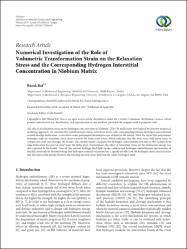| dc.contributor.author | Bal, Burak | |
| dc.date.accessioned | 2019-08-16T09:34:31Z | |
| dc.date.available | 2019-08-16T09:34:31Z | |
| dc.date.issued | 2017 | en_US |
| dc.identifier.citation | ADVANCES IN MATERIALS SCIENCE AND ENGINEERING Article Number: 2036516 DOI: 10.1155/2017/2036516 | en_US |
| dc.identifier.issn | 1687-8434 | |
| dc.identifier.issn | eISSN: 1687-8442 | |
| dc.identifier.other | DOI: 10.1155/2017/2036516 | |
| dc.identifier.other | Article Number: 2036516 | |
| dc.identifier.other | Accession Number: WOS:000400833100001 | |
| dc.identifier.uri | http://acikerisim.agu.edu.tr/xmlui/handle/20.500.12573/82 | |
| dc.description | B. Bal acknowledges the financial support by the Scientific and Technological Research Council of Turkey (TUBITAK) BIDEB-2219 Postdoctoral Research program under Project no. 1059B191501308. The author would also like to acknowledge Professor Nasr Ghoniem for taking part in the discussion during the preparation of research proposal. | en_US |
| dc.description.abstract | The effects of relaxation stress on the hydrogen concentration in Niobium-(Nb-) H media were investigated by iterative numerical modeling approach. To calculate the transformation strain, relaxation stress, and corresponding relaxed hydrogen concentration around an edge dislocation, a new third-order polynomial formulation was utilized in the model. With the aid of this polynomial, hydrogen induced relaxation stress never exceeds the dislocation stress, which indicates that the total stress field never turns to compressive state and diverges the results. The current model calculates the hydrogen concentration not only in the vicinity of an edge dislocation but also far away from the dislocation. Furthermore, the effect of relaxation stress on the interaction energy was also captured in the model. Overall, the current findings shed light on the complicated hydrogen embrittlement mechanisms of metallic materials by demonstrating that hydrogen induced relaxation has a significant effect on the hydrogen atom concentration and the interaction energy between the existing internal stress field and the solute hydrogen atom. | en_US |
| dc.description.sponsorship | Scientific and Technological Research Council of Turkey (TUBITAK) BIDEB-2219 Postdoctoral Research program - 1059B191501308 | en_US |
| dc.language.iso | eng | en_US |
| dc.publisher | HINDAWI LTD, ADAM HOUSE, 3RD FLR, 1 FITZROY SQ, LONDON, W1T 5HF, ENGLAND | en_US |
| dc.relation.ispartofseries | ADVANCES IN MATERIALS SCIENCE AND ENGINEERING;Article Number: 2036516 | |
| dc.rights | info:eu-repo/semantics/openAccess | en_US |
| dc.subject | INDUCED PLASTICITY STEEL | en_US |
| dc.subject | CRACK-TIP PLASTICITY | en_US |
| dc.subject | EMBRITTLEMENT SUSCEPTIBILITY | en_US |
| dc.subject | LOCALIZED PLASTICITY | en_US |
| dc.subject | ASSISTED CRACKING | en_US |
| dc.subject | TRANSPORT | en_US |
| dc.subject | BEHAVIOR | en_US |
| dc.subject | FRACTURE | en_US |
| dc.subject | FE | en_US |
| dc.subject | DISLOCATIONS | en_US |
| dc.title | Numerical Investigation of the Role of Volumetric Transformation Strain on the Relaxation Stress and the Corresponding Hydrogen Interstitial Concentration in Niobium Matrix | en_US |
| dc.type | article | en_US |
| dc.contributor.department | AGÜ, Mühendislik Fakültesi, Makine Mühendisliği Bölümü | en_US |
| dc.contributor.institutionauthor | Bal, Burak | |
| dc.identifier.doi | 10.1155/2017/2036516 | |
| dc.relation.publicationcategory | Makale - Uluslararası Hakemli Dergi - Kurum Öğretim Elemanı | en_US |


















